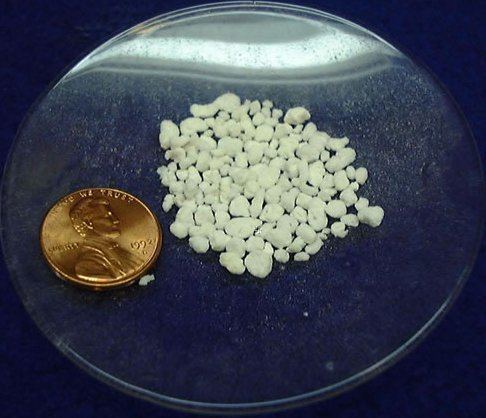 | ||
Perlite is an amorphous volcanic glass that has a relatively high water content, typically formed by the hydration of obsidian. It occurs naturally and has the unusual property of greatly expanding when heated sufficiently. It is an industrial mineral and a commercial product useful for its low density after processing.
Contents
Properties
Perlite softens when it reaches temperatures of 850–900 °C (1,560–1,650 °F). Water trapped in the structure of the material vaporises and escapes, and this causes the expansion of the material to 7–16 times its original volume. The expanded material is a brilliant white, due to the reflectivity of the trapped bubbles. Unexpanded ("raw") perlite has a bulk density around 1100 kg/m3 (1.1 g/cm3), while typical expanded perlite has a bulk density of about 30–150 kg/m3 (0.03-0.150 g/cm3).
Typical analysis of perlite
Production and uses
Perlite is a non-renewable resource. The world reserves of perlite are estimated at 700 million tonnes. In 2011, 1.7 million tonnes were produced, mostly by Greece (500,000 t), United States (375,000 t) and Turkey (220,000 t). However, no information for China – a leading producer – was available. As of 2003, Greece was a leader in processed perlite production; however, estimates of perlite production from the report USGS Mineral Commodity Summaries 2013 indicate that the U.S. may have overtaken Greece.
Because of its low density and relatively low price (about US$50 per tonne of unexpanded perlite), many commercial applications for perlite have developed. In the construction and manufacturing fields, it is used in lightweight plasters, concrete and mortar (masonry), insulation and ceiling tiles. In horticulture, perlite can be used as a soil amendment or alone as a medium for hydroponics or for starting cuttings. When used as an amendment it has high permeability / low water retention and helps prevent soil compaction. Perlite is an excellent filtration aid and is used extensively as an alternative to diatomaceous earth. The popularity of perlite usage as a filter medium is growing considerably worldwide. Perlite filters are fairly commonplace in filtering beer before it is bottled.
Small quantities of perlite are also used in foundries, cryogenic insulation, and in ceramics as a clay additive. It is also used by the explosives industry. Due to thermal and mechanical stability, non-toxicity, and high resistance against microbial attacks and organic solvents, perlite is widely used in biotechnological applications. Perlite was found to be an excellent support for immobilization of biocatalysts such as enzymes for bioremediation and sensing applications.
Substitutes
Perlite can be substituted for all of its uses. Substitutes include:
Occupational safety
People can be exposed to perlite in the workplace by breathing in dust, skin contact, and eye contact.
United States
The Occupational Safety and Health Administration (OSHA) has set the legal limit (permissible exposure limit) for perlite exposure in the workplace as 15 mg/m3 total exposure and 5 mg/m3 respiratory exposure over an 8-hour workday. The National Institute for Occupational Safety and Health (NIOSH) has set a recommended exposure limit (REL) of 10 mg/m3 total exposure and 5 mg/m3 respiratory exposure over an 8-hour workday.
